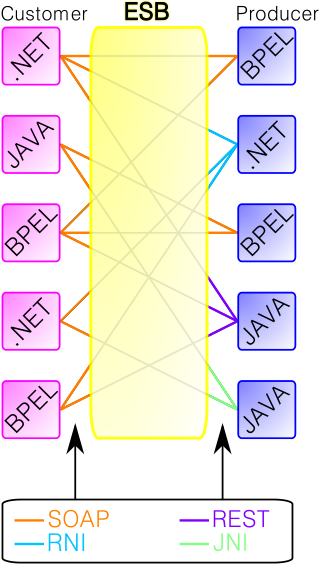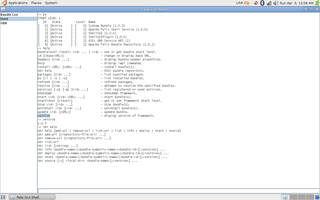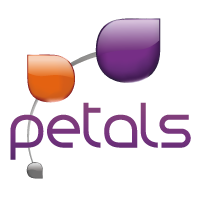Middleware in the context of distributed applications is software that provides services beyond those provided by the operating system to enable the various components of a distributed system to communicate and manage data. Middleware supports and simplifies complex distributed applications. It includes web servers, application servers, messaging and similar tools that support application development and delivery. Middleware is especially integral to modern information technology based on XML, SOAP, Web services, and service-oriented architecture.

An enterprise service bus (ESB) implements a communication system between mutually interacting software applications in a service-oriented architecture (SOA). It represents a software architecture for distributed computing, and is a special variant of the more general client-server model, wherein any application may behave as server or client. ESB promotes agility and flexibility with regard to high-level protocol communication between applications. Its primary use is in enterprise application integration (EAI) of heterogeneous and complex service landscapes.

Apache Flex, formerly Adobe Flex, is a software development kit (SDK) for the development and deployment of cross-platform rich web applications based on the Adobe Flash platform. Initially developed by Macromedia and then acquired by Adobe Systems, Adobe donated Flex to the Apache Software Foundation in 2011 and it was promoted to a top-level project in December 2012.

Apache Geronimo is an open source application server developed by the Apache Software Foundation and distributed under the Apache license.

GlassFish is an open-source Jakarta EE platform application server project started by Sun Microsystems, then sponsored by Oracle Corporation, and now living at the Eclipse Foundation and supported by OmniFish, Fujitsu and Payara. The supported version under Oracle was called Oracle GlassFish Server. GlassFish is free software and was initially dual-licensed under two free software licences: the Common Development and Distribution License (CDDL) and the GNU General Public License (GPL) with the Classpath exception. After having been transferred to Eclipse, GlassFish remained dual-licensed, but the CDDL license was replaced by the Eclipse Public License (EPL).

IONA Technologies was an Irish software company founded in 1991. It began as a campus company linked to Trinity College Dublin had its headquarters in Dublin, and eventually also expanded its offices in Boston and Tokyo. It specialised in distributed service-oriented architecture (SOA) technology, its products connecting systems and applications by creating a network of services without requiring a centralised server or creating an information technology project. IONA was the first Irish company to float on the NASDAQ exchange. It was valued at up to US$1.75 billion at its peak. It was one of the world's 10 largest software-only companies, and around 30 new ventures spun out from it. IONA was sold to Progress Software in 2008.
IBM App Connect Enterprise (abbreviated as IBM ACE, formerly known as IBM Integration Bus, WebSphere Message Broker, WebSphere Business Integration Message Broker, WebSphere MQSeries Integrator and started life as MQSeries Systems Integrator. App Connect IBM's integration software offering, allowing business information to flow between disparate applications across multiple hardware and software platforms. Rules can be applied to the data flowing through user-authored integrations to route and transform the information. The product can be used as an Enterprise Service Bus supplying a communication channel between applications and services in a service-oriented architecture. App Connect from V11 supports container native deployments with highly optimised container start-up times.
OpenESB is a Java-based open-source enterprise service bus. It can be used as a platform for both enterprise application integration and service-oriented architecture. OpenESB allows developers to integrate legacy systems, external and internal partners and new development in business processes. It supports a multitude of integration technologies including standard JBI, XML with support for XML Schemas, WSDL, and BPEL with the aim of simplicity, efficiency, long-term durability, and low TCO.

Apache Felix is an open source implementation of the OSGi Core Release 6 framework specification. The initial codebase was donated from the Oscar project at ObjectWeb. The developers worked on Felix for a full year and have made various improvements while retaining the original footprint and performance. On June 21, 2007, the project graduated from incubation as a top level project and is considered the smallest size software at Apache Software Foundation.
Apache Camel is an open source framework for message-oriented middleware with a rule-based routing and mediation engine that provides a Java object-based implementation of the Enterprise Integration Patterns using an application programming interface to configure routing and mediation rules.
Apache CXF is an open source software project developing a Web services framework. It originated as the combination of Celtix developed by IONA Technologies and XFire developed by a team hosted at the now defunct host CodeHaus in 2006. These two projects were combined at the Apache Software Foundation. The name "CXF" was derived by combining "Celtix" and "XFire".
Service Component Architecture (SCA) is a software technology designed to provide a model for applications that follow service-oriented architecture principles. The technology, created by major software vendors, including IBM, Oracle Corporation and TIBCO Software, encompasses a wide range of technologies and as such is specified in independent specifications to maintain programming language and application environment neutrality. Many times it uses an enterprise service bus (ESB).

Petals ESB is an open-source ESB developed by Linagora. It is a tool for implementing a service-oriented architecture (SOA). It is standard, modular, and physically distributed, to adapt to large-scale infrastructures.
The JBoss Enterprise SOA Platform is free software/open-source Java EE-based service-oriented architecture (SOA) software. The JBoss Enterprise SOA Platform is part of the JBoss Enterprise Middleware portfolio of software. The JBoss Enterprise SOA Platform enables enterprises to integrate services, handle business events, and automate business processes, linking IT resources, data, services and applications. Because it is Java-based, the JBoss application server operates cross-platform: usable on any operating system that supports Java. The JBoss SOA Platform was developed by JBoss, now a division of Red Hat.

The open-core model is a business model for the monetization of commercially produced open-source software. The open-core model primarily involves offering a "core" or feature-limited version of a software product as free and open-source software, while offering "commercial" versions or add-ons as proprietary software. The term was coined by Andrew Lampitt in 2008.

Apache ActiveMQ is an open source message broker written in Java together with a full Java Message Service (JMS) client. It provides "Enterprise Features" which in this case means fostering the communication from more than one client or server. Supported clients include Java via JMS 1.1 as well as several other "cross language" clients. The communication is managed with features such as computer clustering and ability to use any database as a JMS persistence provider besides virtual memory, cache, and journal persistency.
UltraESB is a lightweight enterprise service bus (ESB) capable of supporting many transports and message formats natively. It allows messages to be mediated via Java or JSR 223 scripting languages through an API, and is the first ESB to claim support for Zero-Copy proxying of messages with Non-Blocking IO capabilities. In 2013, it was selected as the ESB and API Management platform by a recent Fortune #1 company based on its performance and stability.

OpenShift is a family of containerization software products developed by Red Hat. Its flagship product is the OpenShift Container Platform — a hybrid cloud platform as a service built around Linux containers orchestrated and managed by Kubernetes on a foundation of Red Hat Enterprise Linux. The family's other products provide this platform through different environments: OKD serves as the community-driven upstream, Several deployment methods are available including self-managed, cloud native under ROSA, ARO and RHOIC on AWS, Azure, and IBM Cloud respectively, OpenShift Online as software as a service, and OpenShift Dedicated as a managed service.
CloudStack is open-source Infrastructure-as-a-Service cloud computing software for creating, managing, and deploying infrastructure cloud services. It uses existing hypervisor platforms for virtualization, such as KVM, VMware vSphere, including ESXi and vCenter, XenServer/XCP and XCP-ng. In addition to its own API, CloudStack also supports the Amazon Web Services (AWS) API and the Open Cloud Computing Interface from the Open Grid Forum.










